Effects of macrophage colony-stimulating factor (M-CSF) on anti-fungal activity of mononuclear phagocytes against Trichosporon asahii
- PMID: 10632665
- PMCID: PMC1905513
- DOI: 10.1046/j.1365-2249.2000.01134.x
Effects of macrophage colony-stimulating factor (M-CSF) on anti-fungal activity of mononuclear phagocytes against Trichosporon asahii
Abstract
Trichosporon asahii is an emerging opportunistic pathogen in immunocompromised patients. Little is known about the mechanisms of host defence against T. asahii. We investigated the fungicidal activity of human peripheral blood monocytes and murine peritoneal macrophages against T. asahii isolates, and the effects of M-CSF on the anti-fungal activity of mononuclear phagocytes. We also established a neutropenic mouse model of disseminated trichosporonosis with T. asahii. M-CSF enhanced the phagocytic fungicidal activity of mononuclear cells, and infected mice treated with human M-CSF at 10 x 106 U/kg showed a significant improvement in survival rate, with fewer fungal colony counts in the lung compared with control mice. Mice treated with human M-CSF showed higher concentrations of tumour necrosis factor-alpha (TNF-alpha) in the lung and plasma compared with control mice. The survival rate was significantly reduced in mice treated with anti-mouse TNF-alpha. Our results showed that M-CSF enhanced the fungicidal activity of mononuclear phagocytes partly by production of TNF-alpha, and suggest that the administration of M-CSF to patients with disseminated trichosporonosis may be a useful adjunct to conventional anti-microbial therapy and prophylaxis.
Figures






Similar articles
-
Effects of granulocyte and granulocyte-macrophage colony-stimulating factors in a neutropenic murine model of trichosporonosis.Infect Immun. 1997 Aug;65(8):3422-9. doi: 10.1128/iai.65.8.3422-3429.1997. Infect Immun. 1997. PMID: 9234807 Free PMC article.
-
Cytokines profile in immunocompetent mice during Trichosporon asahii infection.Med Mycol. 2018 Jan 1;56(1):103-109. doi: 10.1093/mmy/myx018. Med Mycol. 2018. PMID: 28340200
-
Kinetics and dose dependence of macrophage colony-stimulating factor-induced proliferation and activation of murine mononuclear phagocytes in situ: differences between lungs, liver, and spleen.J Interferon Cytokine Res. 1996 Feb;16(2):159-68. doi: 10.1089/jir.1996.16.159. J Interferon Cytokine Res. 1996. PMID: 8742369
-
[Pathogenesis of Trichosporon asahii and strategies for infectious control of disseminated trichosporonosis].Nihon Ishinkin Gakkai Zasshi. 2003;44(3):181-6. doi: 10.3314/jjmm.44.181. Nihon Ishinkin Gakkai Zasshi. 2003. PMID: 12913806 Review. Japanese.
-
[Recent knowledge allowing diagnosis and treatment of deep-seated trichosporonosis].Nihon Ishinkin Gakkai Zasshi. 2000;41(4):235-9. doi: 10.3314/jjmm.41.235. Nihon Ishinkin Gakkai Zasshi. 2000. PMID: 11064321 Review. Japanese.
Cited by
-
Experimental pathogenicity of a clinical isolate of Trichosporon dermatis in a murine model.Mycopathologia. 2011 Nov;172(5):381-7. doi: 10.1007/s11046-011-9442-6. Epub 2011 Jul 13. Mycopathologia. 2011. PMID: 21750940
-
Early transcriptional response of human monocyte-like THP-1 cells in response to Trichosporon asahii infection.Mycopathologia. 2015 Feb;179(1-2):11-20. doi: 10.1007/s11046-014-9784-y. Epub 2014 Sep 2. Mycopathologia. 2015. PMID: 25179349
-
The Cell Biology of the Trichosporon-Host Interaction.Front Cell Infect Microbiol. 2017 Apr 7;7:118. doi: 10.3389/fcimb.2017.00118. eCollection 2017. Front Cell Infect Microbiol. 2017. PMID: 28439501 Free PMC article. Review.
-
Identification of signaling components required for the prediction of cytokine release in RAW 264.7 macrophages.Genome Biol. 2006;7(2):R11. doi: 10.1186/gb-2006-7-2-r11. Epub 2006 Feb 20. Genome Biol. 2006. PMID: 16507166 Free PMC article.
-
Macrophage colony-stimulating factor prevents febrile neutropenia induced by chemotherapy.Jpn J Cancer Res. 2001 Nov;92(11):1251-8. doi: 10.1111/j.1349-7006.2001.tb02147.x. Jpn J Cancer Res. 2001. PMID: 11714451 Free PMC article. Clinical Trial.
References
-
- Tashiro T, Nagai H, Kamberi P, et al. Disseminated Trichosporon beigelii infection in patients with malignant diseases: immunohistochemical study and review. Eur J Microbiol Infect Dis. 1994;13:218–24. - PubMed
-
- Gueho E, Smith MT, de Hoog GS, et al. Contributions to a revision of the genus Trichosporon. Antonie Van Leeuwenhoek. 1992;61:289–316. - PubMed
-
- Nishiura Y, Nakagawa-Yoshida K, Suga M, et al. Assignment and serotyping of Trichosporon species: the causative agents of summer-type hypersensitivity pneumonitis. J Med Vet Mycol. 1997;35:45–52. - PubMed
MeSH terms
Substances
LinkOut - more resources
Full Text Sources
Research Materials

